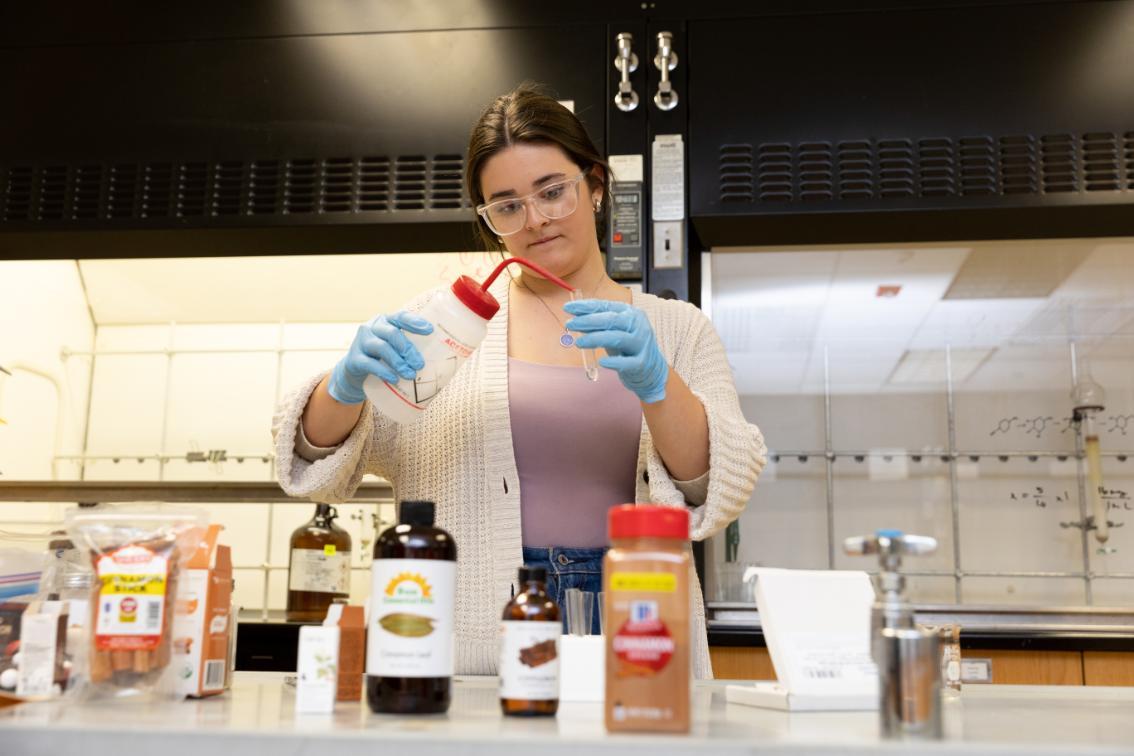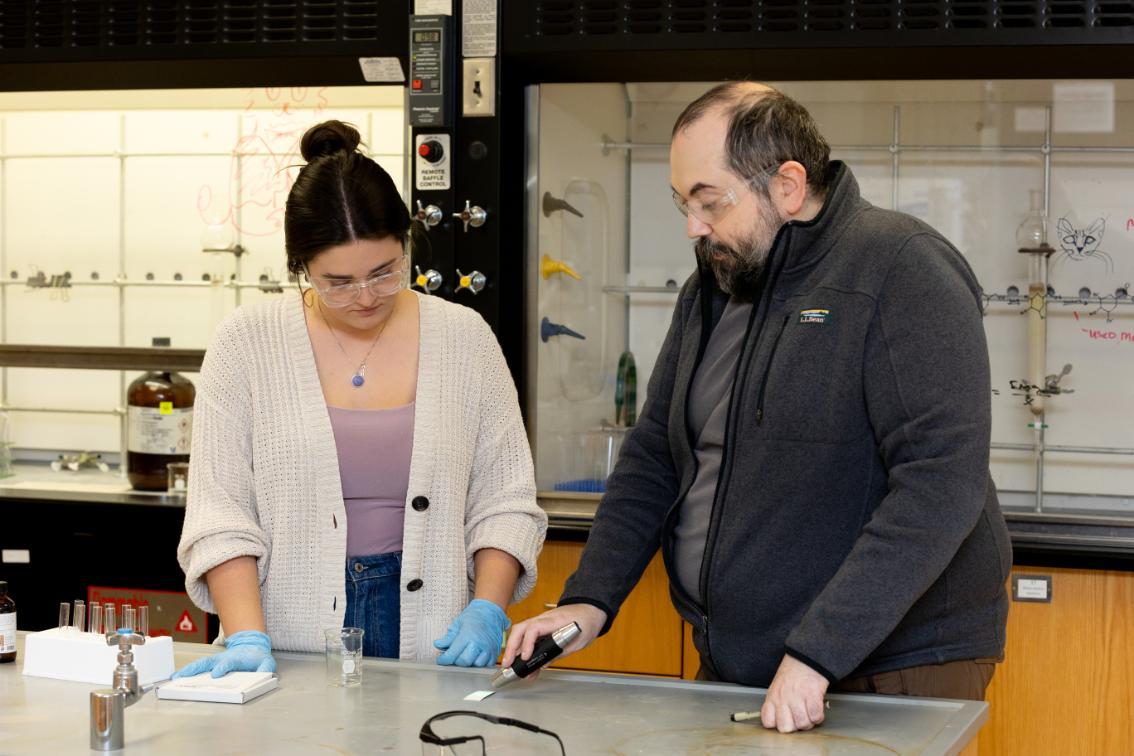

One of the lesser acknowledged truths about chemistry is that it can be smelly. Between pungent compounds and nose-tingling byproducts thrown off by chemical reactions, the aromatics of a lab can range from unpleasant to downright odoriferous.
But for at least a few hours every Friday this fall, the third floor of Longwood’s Chichester Science Center has smelled more like a bakery than a chemistry lab.
That’s because of Moorea Whitfield ’26 and her ongoing work with Associate Professor of Science Education and Chemistry Dr. Tyler St. Clair. The student-faculty duo meets weekly to conduct experiments identifying the compounds in cinnamon—and its lesser-known but more widely available imposter of a relative, cassia.
The crux of their testing is that most of the cinnamon available for purchase in the United States is not, at least according to cooking enthusiasts and health experts, “true cinnamon.” It’s actually cassia, a lower-quality cousin of the true, Sri Lankan-grown cinnamon plant. Cassia has a stronger aroma and thicker bark, while true cinnamon—called Ceylon—has a milder fragrance and a more brittle bark, and is grown only in Sri Lanka.
Companies are allowed to market and sell both Ceylon and cassia under the general name cinnamon, but, while both come from the bark of trees in the Cinnamomum genus, they’re noticeably different in aroma, taste and chemical makeup. That’s due in large part to a compound called coumarin.
Cassia cinnamon is much cheaper to produce and purchase. Everyone knows cinnamon has a lot of good health properties, but that can be misleading if it has coumarin in it.
Moorea Whitfield '26
“Cassia cinnamon is much cheaper to produce and purchase,” Whitfield said. “Everyone knows cinnamon has a lot of good health properties, but that can be misleading if it has coumarin in it.”
Side by side, cassia and Ceylon serve a similar purpose and do so to similar effect. However, cassia possesses a larger amount of the aforementioned coumarin, which has been linked to liver toxicity in studies performed in mice.
But don’t panic and go cleaning out your spice rack during pumpkin-pie season, says Whitfield.
“This isn’t to scare anyone into thinking coumarin or cassia that’s mislabeled as cinnamon is bad,” she said. “Some people have said, ‘Why aren’t more people freaking about this?’ But it’s really only in very large amounts where studies in mice have shown it becomes a problem.”
The differences between cassia and Ceylon are well-known and documented, even if they’re not readily apparent to consumers. So, while Whitfield’s ongoing experimentation isn’t breaking new ground in dietary science, it’s serving another purpose: to prepare her for a future career as a chemistry teacher.
“Basically what I’m doing is designing a unit for high school,” she said. “I want to be a high school chemistry teacher, and this lesson will focus on intermolecular forces and thin-layer chromatography. It’s a way of separating components within a compound to see exactly what’s in there.”
Thin-layer chromatography (TLC) is a scientific process that uses small paper strips upon which Whitfield places a miniscule amount of cinnamon oil or another compound prepared from ground cinnamon or cinnamon bark. The strips, called plates, then sit vertically in a solution, which climbs its way upward. Along the way, the solution separates components within the compound, like coumarin, and Whitfield then uses a special UV light to determine how much coumarin is present. High levels indicate the product is cassia cinnamon, while low or nondetectable levels indicate it’s Ceylon.

Throughout the semester, Whitfield has used what she’s learned to design a comprehensive lesson plan that introduces high school students to TLC. That includes not only instructions for how to conduct the experiment but also resources and guidance on how to accurately collect and analyze the results.
And while Chichester’s well-stocked laboratories allow Whitfield access to an array of chemicals, beakers, UV lights and professional-grade TLC plates, her goal throughout the semester has been to make the lesson scalable and safe for use in even the most bare-bones classroom.
“You can really conduct TLC experiments with just the ink in felt-tip markers as the compound and water as the separating solution,” she said. “The end goal is to design a practical experiment that teachers in many grades can do in their classrooms. This should all be usable for teachers and students so they can conduct it themselves and draw conclusions from the results.”
Throughout the semester, Whitfield has kept detailed notes of both her successes and failures conducting the TLC experiments on cinnamon. The repetition, along with sample lessons she has delivered to fellow students, has allowed her to tweak her lesson into something that she will be able to deploy immediately upon beginning her teaching career.
It’s also something she is already sharing with her fellow educators, including at the annual Virginia Association of Science Teachers conference in November. Whitfield and St. Clair presented her full lesson plan, the work that went into designing it, and the broader economic and health implications of the cassia-vs.-Ceylon issue at the conference, held in Alexandria. Whitfield’s Longwood classmate Andrew Schaefer ’26 also presented at the conference, whose aim is to provide professional development and networking opportunities for science educators at all grade levels.
More broadly, the cinnamon-vs.-cassia topic is an example of academic work that ties into Civitae [Longwood’s core curriculum]. You’re finding an issue, you’re finding a place where the issue exists, and you’re looking at the bigger picture.
Dr. Tyler St. Clair, associate professor of science education and chemistry
Additionally, Whitfield and St. Clair plan to submit their work to a professional educator’s journal in the spring. St. Clair is also working to expand the experiments into a larger flavors and fragrances course in the future.
“That’s still in the works, but this particular experiment was originally part of the labs for that,” he said. “More broadly, the cinnamon-vs.-cassia topic is an example of academic work that ties into Civitae [Longwood’s core curriculum]. You’re finding an issue, you’re finding a place where the issue exists, and you’re looking at the bigger picture. With cinnamon, it’s a consumer issue, a marketing issue, an economic issue.”
It’s also an olfactory issue—one that’s breathing a welcome aroma into the busy halls of Longwood’s science hub.
